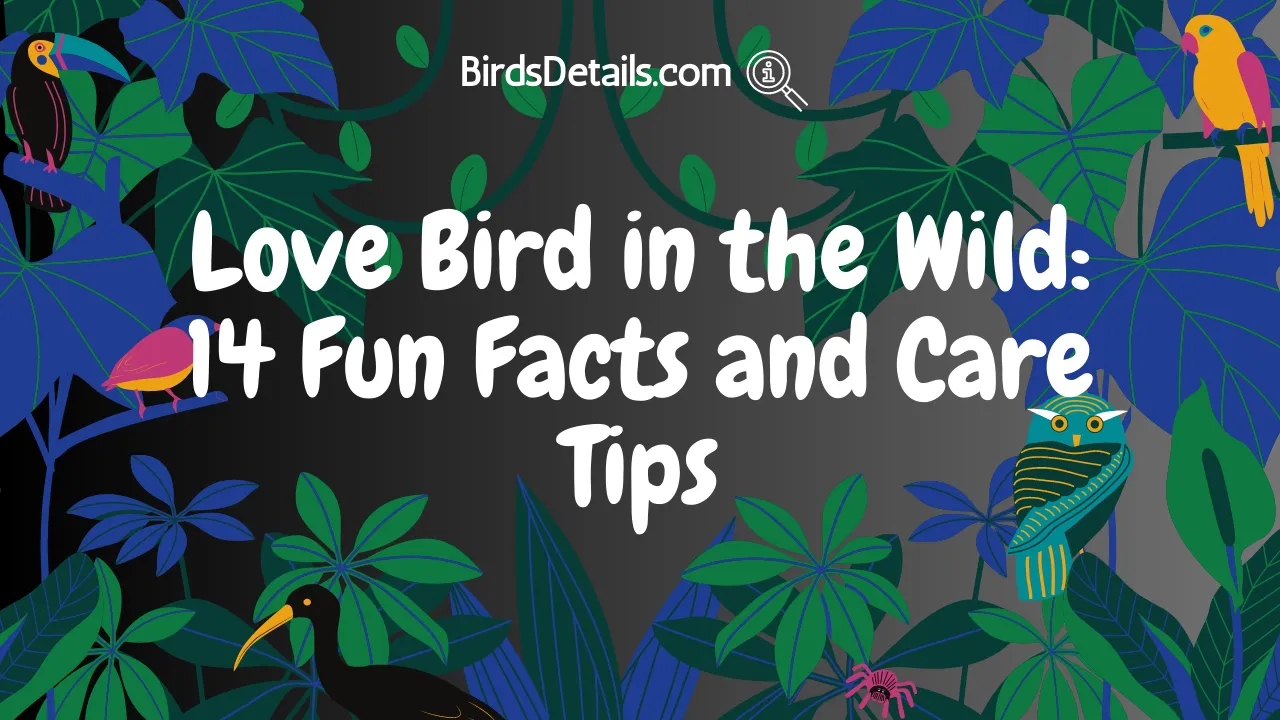Have you ever seen a lovebird in the wild? These small, colorful parrots from the genus Agapornis are native to various parts of Africa and are known for their strong bond with their partners. The Agapornis roseicollis and Agapornis personatus are popular species that can also thrive in an aviary. In this post, we will explore the world of wild love birds and discover what makes them such fascinating creatures.
Wild lovebirds of the genus Agapornis, such as the Agapornis roseicollis species, live in flocks and are highly social creatures that mate for life. They exhibit affectionate behaviors such as preening each other’s feathers and often stay close to their partners even when they are not mating. Their distinctive chirping and squawking sounds are used to communicate with their flock members. In captivity, they thrive in aviaries where they can fly and interact with other parrot species.
Lovebirds, also known as agapornis, are a parrot species that primarily feed on seeds, fruits, and vegetation in the wild. However, they also eat insects and small invertebrates to maintain their health and vitality in the harsh African environment. These adorable birds have become popular pets for humans, especially during Valentine’s Day.
While lovebirds, also known as Agapornis, make popular pets due to their colorful appearance and affectionate nature, it is important to remember that they are parrots. As such, they require specialized care to thrive in captivity. If you want a hand-raised female agapornis, ensure you find a reputable breeder.
In this post, we will delve deeper into the world of wild love birds, also known as agapornis. We’ll examine their behavior patterns, feeding habits, communication methods, and more, while also exploring their lifespan. By gaining a better understanding of these fascinating creatures’ lifespans, we can appreciate them even more when we encounter them in the wild or keep them as pets.
So let’s dive into the world of wild lovebirds, also known as agapornis, and learn about their lifespan together!
Fun Facts:
- Lovebirds are native to Africa and live in a variety of habitats, including forests, savannas, and woodlands.
- They are social birds and live in flocks of up to 100 birds.
- Lovebirds are monogamous and mate for life.
- The female lays 4-6 eggs, which hatch after about 20 days.
- The young birds fledge after about 6 weeks.
- Lovebirds are known for their loud chirping and whistling.
- They are also known for their ability to mimic human speech.
Care Tips:
- If you are thinking about getting a lovebird as a pet, it is important to do your research and make sure that you are prepared to provide the bird with the proper care. Lovebirds require a spacious cage, a varied diet, and plenty of social interaction.
- The cage should be at least 24 inches wide, 18 inches deep, and 20 inches high for a single lovebird.
- The cage should be made of a sturdy material, such as metal or wood.
- The cage should have a secure door to prevent the lovebird from escaping.
- The cage should be placed in a quiet area of the home, away from drafts and direct sunlight.
- Lovebirds should be fed a diet of fruit, vegetables, seeds, and pellets.
- The diet should be high in fiber and low in fat.
- Fresh fruit and vegetables should be offered daily.
- Seeds and pellets should be offered as a supplement.
- Lovebirds should always have access to fresh water.
- Lovebirds are social birds and need plenty of interaction with their owners.
- Spend at least 2-3 hours each day interacting with your lovebird.
- Talk to your lovebird, play with them, and give them plenty of attention.
- Lovebirds can be trained to perform tricks.
- Start by teaching your lovebird simple commands, such as “step up” and “come.”
- Be patient and consistent with your training.
With proper care, lovebirds can make wonderful companions for people of all ages.
Lovebirds in Their Natural Habitat
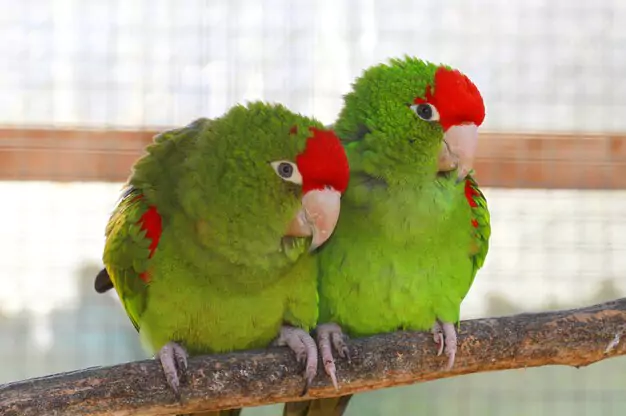
Social Birds That Thrive in Small Flocks
Lovebirds have a relatively long lifespan for a small bird, with some living up to 15 years in captivity. They are social birds that thrive in small flocks, engaging in playful behavior and vocalizing to communicate with each other. In their natural habitat, they can be found living together with other lovebirds, usually consisting of a mated pair and their offspring, but sometimes several pairs may share the same nesting site or roosting area.
Different Species of Lovebirds with Unique Plumage and Behaviors
There are several species of lovebirds, including the masked lovebird and the faced lovebird. These species have distinct plumage and behaviors that make them unique from one another. For example, the masked lovebird has a black mask around its eyes, while the faced lovebird has a white ring around its eyes.
Each species, including wild lovebirds, also has its personality traits. Some are more aggressive than others, while some are more timid. Different species have different preferences and varying lovebird lifespans.
Parrots Known for Strong Bonds with Their Mates
Lovebirds are a type of parrot known for their strong bonds with their mates. They often engage in displays of affection such as preening each other’s feathers or feeding each other. During mating season, they also perform elaborate courtship rituals to attract potential mates.
These strong bonds between mates help ensure successful breeding and offspring survival. Some studies have shown that bonded pairs of lovebirds have higher reproductive success rates compared to non-bonded pairs.
Found in Various Habitats Contributing to Pollination and Seed Dispersal
Lovebirds can be found in various habitats such as savannas, forests, and grasslands across Africa and Madagascar. They play an important role in pollination by feeding on nectar-producing flowers and spreading pollen from one flower to another.
They also contribute to seed dispersal by consuming fruits and seeds and then excreting them in different locations. This helps to maintain plant diversity and promote forest regeneration. Wild lovebirds, with a lifespan of up to 20 years, are known to play a significant role in this process.
Wild Animals that Require Specific Care and Attention
While lovebirds can thrive in aviary settings, they are wild animals that require specific care and attention to maintain their health and well-being. In the wild, lovebirds have access to a variety of food sources, such as fruits, seeds, insects, and nectar-producing flowers.
In captivity, it is important to provide a balanced diet that includes fresh fruits and vegetables, high-quality pellets or seed mixes, and occasional treats such as millet or nuts. Lovebirds also need plenty of space for exercise and playtime.
It is also important to provide wild lovebirds with toys for mental stimulation as they are intelligent birds that enjoy exploring their environment. Regular veterinary check-ups are also essential to ensure they remain healthy and live a long lovebird lifespan.
Fischer’s Lovebirds: A Unique Species
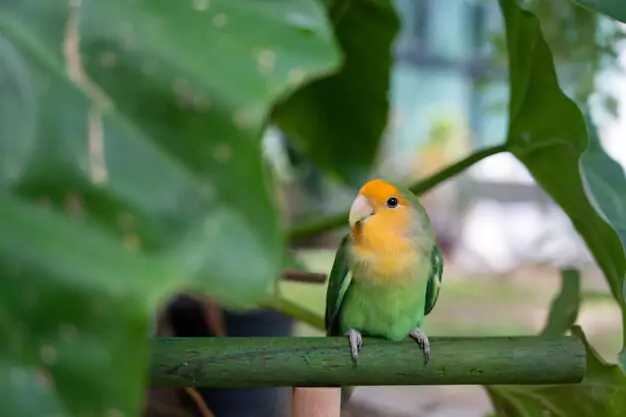
What are Fischer’s lovebirds?
Fischer’s lovebirds, also known as Agapornis fischeri, are a unique species of lovebird that are native to a small region in Tanzania. These birds were named after German explorer Gustav Fischer, who first discovered the species in the late 19th century. They belong to the genus Agapornis, which includes several other species of small parrots such as the popular pet bird, the roseicollis or Agapornis roseicollis.
Distinctive features of Fischer’s lovebirds
One of the most distinctive features of Fischer’s lovebirds is their bright green plumage, which is accented by a variety of colors on their head and wings. Their beaks are short and curved, which helps them crack open seeds and nuts. They have strong legs and feet that allow them to climb around trees and bushes with ease.
Unlike many other species of lovebirds, Fischer’s lovebirds are monogamous and form strong pair bonds with their mates. They communicate with each other through various sounds including chirps, whistles, and squawks.
Fischer’s lovebirds are social birds that live in flocks ranging from a few pairs to up to 30 individuals. They spend much of their time foraging for food on the ground or in trees. Their diet consists mainly of seeds, fruits, berries, and insects.
Caring for Fischer’s lovebirds
If you’re interested in keeping Fischer’s lovebirds as pets, it’s important to provide them with a spacious cage that allows them plenty of room to move around. The cage should be equipped with perches at different heights so they can exercise their legs and feet. It should also have toys such as swings and bells to keep them entertained.
In terms of diet, it’s best to offer your lovebirds a varied diet that includes a mix of seeds, fruits, and vegetables. You can also offer them occasional treats such as millet or cooked eggs.
It’s important to keep your lovebirds’ cage clean by replacing their food and water daily and cleaning the cage thoroughly once a week. You should also provide your birds with fresh water for bathing at least once a week.
Lovebird Lifespan: How Long Do Lovebirds Live in the Wild and Captivity?

Wild Lovebirds Live for 10-15 Years
Lovebirds are small, colorful parrots that are native to Africa. In the wild, they have a lifespan of around 10 to 15 years, depending on various factors such as genetics, diet, environment, and healthcare. These birds are social creatures that mate for life and live in large flocks. They are known for their playful behavior and affectionate nature towards their partners.
Wild lovebirds face many challenges in their natural habitat that can affect their lifespan. For instance, they may fall prey to predators such as hawks or snakes. They may contract diseases or suffer from malnutrition due to a lack of food sources.
Captive Lovebirds Can Live Up to 20 Years or More
In captivity, lovebirds can live up to 20 years or more with proper care and nutrition. This is because captive lovebirds have access to a consistent supply of food and water, protection from predators, and regular veterinary care.
To ensure your pet lovebird lives a long and healthy life in captivity, you should provide them with a balanced diet consisting of seeds, pellets, fruits, vegetables, and occasional treats like millet sprays. You should also make sure your bird has access to fresh water at all times.
Another important factor that affects the lifespan of captive lovebirds is exercise. These birds need plenty of space outside of their cages where they can fly around freely and get some exercise. You should aim to let your bird out of its cage for at least an hour every day so it can stretch its wings.
Breeding Periods for Lovebirds
Lovebirds reach sexual maturity at around one year of age. At this point, males will start courting females by singing songs or offering food items as gifts. This is when breeding season begins, and lovebirds can breed for several years before their reproductive abilities decline. In captivity, you should provide your birds with a suitable nesting box where they can lay their eggs.
Lovebird eggs typically take around 23 days to hatch. After hatching, the chicks will stay in the nest for another four to five weeks until they are ready to fledge (leave the nest). During this time, you should make sure that both parents have access to plenty of food and water so they can feed their young.
Lovebirds’ Diet and Nutrition: What They Eat in the Wild and Captivity
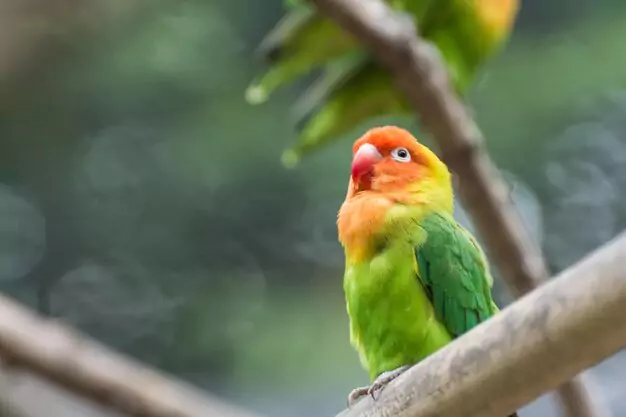
Lovebirds’ Natural Diet
Lovebirds are small parrots that are native to Africa. In the wild, they primarily feed on a diet of seeds, fruits, and vegetables. Their natural habitat provides them with a variety of food sources, including berries, figs, grasses, and flowers.
Seeds make up the bulk of their diet. They prefer to eat fresh seeds that have not yet ripened fully. Sunflower seeds are one of their favorites. Lovebirds also enjoy eating dark leafy greens such as kale and spinach.
In addition to seeds and greens, lovebirds will occasionally eat insects or other small animals if they come across them while foraging. However, this is not a significant part of their diet.
Lovebirds’ Captive Diet
It’s essential to provide wild lovebirds with a balanced diet that meets all of their nutritional needs. A well-balanced diet should consist of pellets as the primary source of nutrition along with fresh fruits and vegetables.
Pellets are specially formulated bird food that contains all the necessary nutrients required for your lovebird’s health. Pellets come in different colors representing different flavors; however, it would be best if you avoided giving your lovebird-colored pellets because these contain artificial dyes that can harm your bird’s health.
Fruits such as apples, pears, bananas, and grapes are excellent sources of vitamins for your lovebird. Vegetables like carrots, broccoli leaves or stems (not heads), and sweet potatoes are also beneficial for your bird’s overall health.
It is crucial to avoid feeding your lovebird foods high in fat or sugar because these can lead to obesity and other health problems such as fatty liver disease or diabetes mellitus type 2.
Water Intake
Water is an essential element. Lovebirds require fresh, clean water to drink every day. You should change your lovebird’s water daily and clean their water dish regularly.
Lovebirds are notorious for playing with their water bowl, so it is essential to have a water bottle attached to the cage as well. This ensures that they always have access to fresh drinking water.
Interesting Facts About Lovebirds

Lovebirds are monogamous birds that mate for life, and they often display affectionate behaviors towards their partners such as preening and feeding each other.
Lovebirds are known for their strong bond with their partners. They form a deep connection with their mate and stay together for the rest of their lives. They are very affectionate towards each other and display it through various behaviors like preening, feeding each other, and sitting close to one another. When one partner is away from the nest, the other will wait patiently until they return. This behavior shows how committed lovebirds are to their partners.
There are nine different species of lovebirds, all of which are native to Africa except for one species found in Madagascar.
Lovebirds come in nine different species, all of which have unique characteristics. The most common species kept as pets is the peach-faced lovebird. Other species include Fischer’s lovebird, black-cheeked lovebird, Nyasa lovebird, red-headed lovebird, Abyssinian lovebird, Madagascar lovebird (the only non-African species), masked lovebird and yellow-collared lovebird. Each type has its coloration patterns and physical features that make them distinct from others.
Lovebirds are known for their distinctive chirping and vocalizations, which they use to communicate with their partners and other birds in their flock.
Lovebirds communicate through a range of sounds including chirps, calls, whistles, or squawks. These sounds help them communicate with each other about food sources or potential predators nearby. They also use these sounds to show affection towards each other by singing duets or making soft cooing noises while snuggling up together.
In the wild, lovebirds primarily feed on seeds, fruits, and vegetation but have also been known to eat insects and small invertebrates.
Lovebirds’ diet mainly consists of seeds, fruits, and vegetation. They enjoy a variety of foods including millet, sunflower seeds, berries, and fresh greens. Insects and small invertebrates are also part of their diet, especially during breeding season when they need extra protein to feed their chicks. Lovebirds have strong beaks that help them crack open seeds and nuts.
Why are lovebirds called lovebirds?
Lovebirds got their name because of their strong bond with their partners. Their monogamous behavior and affectionate gestures towards each other earned them the nickname “lovebirds.” They are often seen cuddling up together or grooming each other’s feathers, which is why they are considered symbols of love and devotion.
How many lovebirds are left?
It is challenging to estimate the exact number of wild lovebirds remaining since they live in various regions across Africa. However, some species such as the black-cheeked lovebird have become endangered due to habitat loss from deforestation and poaching for the pet trade. Conservation efforts are being made to protect these birds’ habitats and prevent further population decline.
The Importance of Leaving Lovebirds in the Wild

Lovebirds: More Than Just Cute Pets
Lovebirds are small, colorful parrots that are native to Africa. They have become popular pets due to their vibrant plumage and affectionate nature, but these birds play a much more significant role in the ecosystem than just being cute companions. As seed dispersers and pollinators, lovebirds help maintain the health and diversity of their native habitats. Unfortunately, capturing lovebirds from the wild for the pet trade has led to a decline in their populations.
The Impact of Captivity on Lovebird Populations
The demand for lovebirds as pets has led to widespread trapping and exporting of these birds from their natural habitats. This practice not only harms individual birds but also disrupts entire ecosystems. When lovebirds are taken from the wild, they cannot fulfill their natural roles as seed dispersers and pollinators, which can have cascading effects on other plant and animal species in their habitats.
Furthermore, many captive lovebirds are released into the wild by owners who can no longer care for them or who hope to establish feral populations for hunting or other purposes. These feral populations can harm native species by competing with them for resources such as food and nesting sites.
The Benefits of Leaving Lovebirds in the Wild
Leaving lovebirds in the wild allows them to fulfill their natural roles in the ecosystem while also contributing to genetic diversity within their populations. Genetic diversity is essential for maintaining healthy populations that can adapt to changing environmental conditions such as climate change or disease outbreaks.
Conservation efforts aimed at protecting lovebird habitats and reducing demand for captive birds can help ensure that these colorful and charismatic birds continue to thrive in the wild. By supporting conservation initiatives such as habitat restoration projects or ecotourism ventures that benefit local communities while also promoting sustainable practices, we can help protect not only lovebird populations but also entire ecosystems.
Aggression Problems with Other Birds and Animal Species
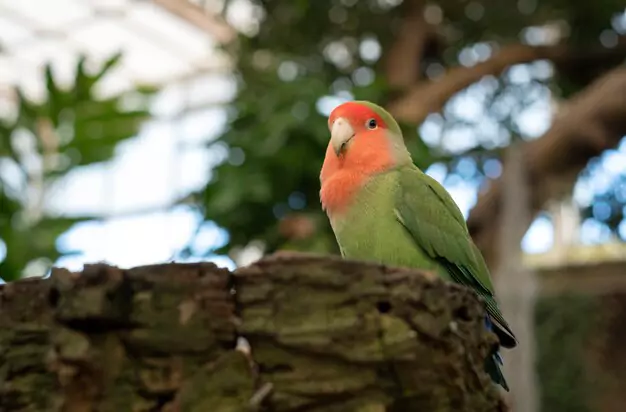
Love Birds Can Exhibit Aggression Towards Other Bird Species in the Wild
Love birds are known for their playful and affectionate nature, but can also be quite aggressive during mating season or when defending their territory. It is not uncommon for love birds to chase other birds away from their nesting sites or even attack them. If you’re considering getting a lovebird as a pet, it’s important to note that their lifespan can range from 10 to 15 years with proper care.
In some cases, love birds may also exhibit aggressive behavior towards humans who come too close to their nests. This is why people need to respect the boundaries of these animals and keep a safe distance.
Love Birds May Also Attack Small Animals and Insects That They Perceive as a Threat
Aside from attacking other bird species, love birds may also exhibit aggression towards small animals and insects that they perceive as a threat. This could include anything from rodents to spiders.
While this behavior may seem harmless at first glance, pet owners need to understand that this aggression could potentially harm other pets or wildlife if left unchecked.
Owners of Pet Love Birds Should Be Aware of This Behavior and Take Precautions
If you own a pet love bird, you must be aware of their potential for aggressive behavior towards other animals. Taking steps to prevent your bird from harming others can help avoid any unwanted incidents.
Proper training and socialization can help reduce the likelihood of aggression towards other animals. It’s important to introduce your bird to different types of animals at an early age so that they become accustomed to them.
Providing your lovebird with plenty of exercise opportunities can help reduce stress levels and prevent aggressive behavior from occurring in the first place.
Housing and Environment for Pet Lovebirds
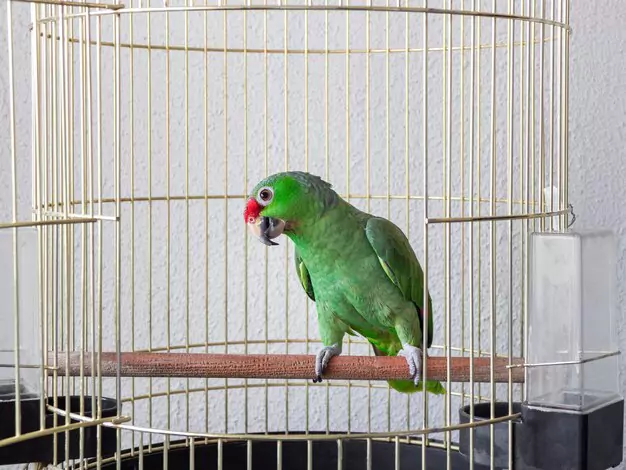
Lovebirds: Good Pets that Need Proper Housing and Environment
Lovebirds are good pets that require proper housing and environment to thrive. As social birds, lovebirds need companionship, stimulation, and plenty of room to play. They are active and playful birds that enjoy climbing, swinging, chewing, and exploring their surroundings. In the wild, lovebirds live in flocks and spend most of their time flying around, searching for food, nesting sites, or socializing with other birds. Therefore, it is essential to provide them with a spacious cage or room where they can express their natural behavior.
Spacious Cage or Room for Exercise and Play
Pet lovebirds should be kept in a spacious cage or room with enough room for exercise and play. The cage should be large enough to allow the bird to fly from one end of the cage to the other without hitting its wings on any objects inside the cage. A minimum size requirement for a single lovebird is 18 inches long by 18 inches wide by 24 inches tall. However, if you plan on keeping more than one bird together in the same cage, you will need a larger enclosure.
When choosing a location for your pet’s cage or room, avoid areas with direct sunlight or drafts. Also, make sure there are no toxic plants nearby as these can harm your bird if ingested.
In addition, providing ample space for exercise and playtime outside of the cage is also important. Lovebirds enjoy spending time outside their cages playing with toys such as swings or perches.
Nests and Nesting Material
Providing a nest or nesting material is important for pet lovebirds to express their natural behavior and instincts. Lovebirds have an innate desire to build nests using materials such as twigs, leaves, grasses, and feathers among others which they collect using their beaks.
To encourage this behavior in captive lovebirds, you can provide them with nesting material such as coconut fiber, shredded paper, or unscented tissues. You can also place a nest box in their cage to provide a safe and comfortable place for your pet lovebird to lay eggs if it chooses to do so.
Regular Cleaning and Care of the Cage or Room
Regular cleaning and care of the cage or room are necessary to maintain a healthy environment for pet lovebirds. Lovebirds are messy birds that produce a lot of dust, feathers, and droppings. Therefore, it’s important to clean their cages regularly by removing any uneaten food, debris, and droppings.
To prevent odor buildup in your pet’s cage or room, you should change the bedding at least once per week. Also, make sure that the water dish is cleaned daily to prevent bacterial growth.
Building a Bond with Your Pet Lovebird

Understanding Your Pet Lovebird
Lovebirds are known for their affectionate nature and social behavior, making them popular pets among bird enthusiasts. Two of the most popular species of pet lovebirds are faced lovebirds and collared lovebirds. Before building a bond with your pet lovebird, it’s essential to understand their unique personalities and preferences.
Parrots, including lovebirds, have distinct personalities and can vary greatly in their likes and dislikes. Some may enjoy cuddling while others prefer to be left alone. Spend time observing your pet’s behavior to better understand what they enjoy. This can help you build trust with your pet by providing positive reinforcement through activities that they find enjoyable.
Consistent Interaction is Key
Building a strong bond with your pet lovebird requires consistent interaction. Spend time each day talking to your bird, offering treats, playing games, or teaching them new tricks. These interactions not only provide mental stimulation but also help establish trust between you and your bird.
It’s important to remember that building a bond takes time and patience. Don’t get discouraged if progress seems slow at first; continue to consistently interact with your bird daily.
Pairing Your Lovebird
Lovebirds thrive in pairs as they are highly social creatures that require companionship for their well-being and happiness. If you only have one lovebird, consider breeding them or getting another companion for them.
Breeding is an option if you have experience caring for birds and the necessary equipment. However, it’s important to note that breeding can be challenging and requires careful consideration before proceeding.
If breeding isn’t an option for you, consider getting another companion for your bird instead. Introducing two birds can take time as they establish dominance within the flock hierarchy; however, once established, the two birds will provide each other with companionship while strengthening their bond with you.
Signs of Affection
Lovebirds show affection through various behaviors such as preening, cuddling, and chirping. These behaviors indicate that your bird trusts and enjoys your company.
Preening is a behavior in which a bird cleans and straightens its feathers. If your lovebird preens in front of you, it’s a sign that they trust you and feel comfortable in your presence.
Cuddling is another sign of affection. Lovebirds enjoy snuggling up to their owners or other birds in their flock. If your bird cuddles with you, it’s a sign that they see you as a trusted companion.
Chirping is also a common behavior among lovebirds. They use chirps to communicate with their owners or other birds. If your bird chirps when you enter the room, it’s a sign that they are happy to see you.
Frequently Asked Questions
- How do I bond with my lovebird? Consistent interaction through activities such as talking, playing games, offering treats, or teaching them new tricks can help establish trust between you and your pet lovebird.
- How long does it take for lovebirds to bond with you? Building a bond takes time and patience; progress may seem slow at first but continue to consistently interact with your bird daily.
- How do I know if my lovebird is happy? Signs of affection such as preening, cuddling, and chirping indicate that your lovebird trusts and enjoys your company.
- How old is my lovebird? You can determine the age of your lovebird by looking at their eyes. Younger birds have dark irises while older birds have lighter irises.
- Why is my lovebird screaming? Screaming can be an indication of boredom or anxiety. Ensure that your bird has enough mental stimulation through toys or interactions with their owner or other birds in their flock.
- How long can you leave a lovebird alone? It’s not recommended to leave your lovebird alone for extended periods as they require social interaction and mental stimulation. If you must be away, ensure that your bird has enough food, water, and toys to keep them occupied.
Lovebird Species: Which One Makes the Best Companion Pet?
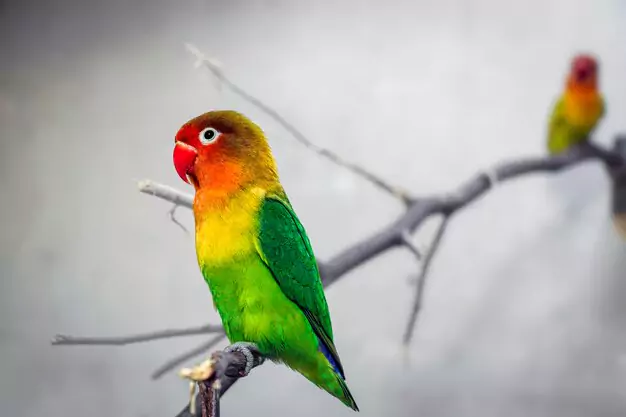
Lovebirds as Small Parrots
Lovebirds are small parrots that come in a wide variety of species. These birds are known for their playful and affectionate nature, making them excellent companion pets for bird lovers. However, not all lovebird species make good pets, and some require more attention and socialization than others to thrive.
Single Lovebirds: A Great Choice
Single lovebirds can make excellent companion pets if you have the time and energy to devote to them. They crave attention and social interaction from their owners, so it’s important to spend plenty of time playing with them. If you’re considering getting a single lovebird as a pet, be prepared to provide lots of toys and activities to keep your feathered friend entertained.
The Peach-Faced Lovebird: A Popular Choice
The Peach-Faced Lovebird, also known as the Rosy-Faced Lovebird, is one of the most popular species of lovebirds kept as pets due to its playful and affectionate nature. These birds are highly social creatures that form strong bonds with their owners. They enjoy being held and cuddled but can become aggressive if they feel threatened or stressed.
Peach-faced lovebirds are relatively easy to care for but require plenty of attention and socialization to stay healthy and happy. They should be housed in pairs or groups since they thrive on social interaction with other birds.
Other Popular Lovebird Species
While the Peach-Faced Lovebird is undoubtedly one of the most popular species kept as pets, there are several other lovebird species worth considering:
- Masked Lovebird: This small parrot gets its name from the black mask-like feathers around its eyes. It’s an active bird that loves to play but can be quite noisy.
- Fischer’s Lovebird: This bird has a distinctive orange face with green feathers on its back. It’s known for being playful and curious but can be aggressive towards other birds.
- Black-Cheeked Lovebird: As its name suggests, this bird has black feathers on its cheeks. It’s a social bird that enjoys the company of others and is relatively easy to care for.
Each lovebird species has its unique physical features and personality traits, so it’s important to do your research before choosing one as a pet. Consider factors like noise level, activity level, and socialization needs when making your decision.
Frequently Asked Questions
How Many Lovebirds Can Live Together in One Cage?
Lovebirds are highly social creatures that thrive on interaction with other birds. They should always be housed in pairs or groups unless you plan to spend a significant amount of time interacting with them yourself. The number of lovebirds that can live together in one cage depends on the size of the cage and the personalities of the birds involved. As a general rule, you should provide at least 18 inches of space per bird to ensure they have enough room to move around comfortably.
Where Can I Find Lovebirds for Sale?
You can find lovebirds for sale at most pet stores that specialize in birds or exotic animals. You may also be able to find them through breeders or online marketplaces like Craigslist or Facebook Marketplace. Be sure to do your research before purchasing a lovebird from any source to ensure they’re healthy and cared for.
How Many Lovebirds Should I Get?
If you’re planning to keep lovebirds as pets, it’s best to get them in pairs or groups since they thrive on social interaction with other birds. However, if you don’t have the space or resources to care for multiple birds, a single lovebird can make an excellent companion pet if given plenty of attention and socialization.
The Pros and Cons of Keeping Lovebirds as Pets

Lovebirds are beautiful and social birds that have captured the hearts of many bird lovers. However, before deciding to keep lovebirds as pets, it is important to consider both the pros and cons.
On the positive side, lovebirds make great companions. They are intelligent birds with playful personalities that can provide endless hours of entertainment for their owners. They form strong bonds with their owners and can become very affectionate.
However, there are also some downsides to keeping lovebirds as pets. One major issue is aggression towards other birds or animals in the household. Lovebirds can be territorial and may attack other pets or even humans if they feel threatened.
Another consideration is the amount of care required for these birds. Lovebirds require a lot of attention and socialization to stay happy and healthy. They need regular interaction with their owners, as well as a nutritious diet and a clean living environment.
It is important to remember that lovebirds are wild animals at heart. While they can adapt to life in captivity, they still have instincts that may not be fully satisfied in a domestic setting.
Overall, while lovebirds can make wonderful pets for those who are willing to put in the time and effort required for their care, it is important to carefully weigh both the benefits and drawbacks before making a decision.
FAQs:
- Can I keep multiple lovebirds together?
- Yes! Lovebirds are social birds and enjoy having company from other lovebird companions.
- What kind of diet should I feed my pet lovebird?
- A balanced diet consisting of seeds, pellets, fresh fruits, and vegetables will keep your lovebird healthy.
- Are there any health concerns specific to lovebirds?
- Yes! Lovebirds are prone to respiratory infections so it’s important to keep their living area clean.
- How long do lovebirds typically live?
- In the wild, lovebirds typically live for around 10 years. However, with proper care in captivity, they can live up to 15 years or more.
- Can lovebirds learn to talk?
- While lovebirds are not known for their ability to mimic human speech like parrots, they can learn a few words and phrases if trained consistently from a young age.
